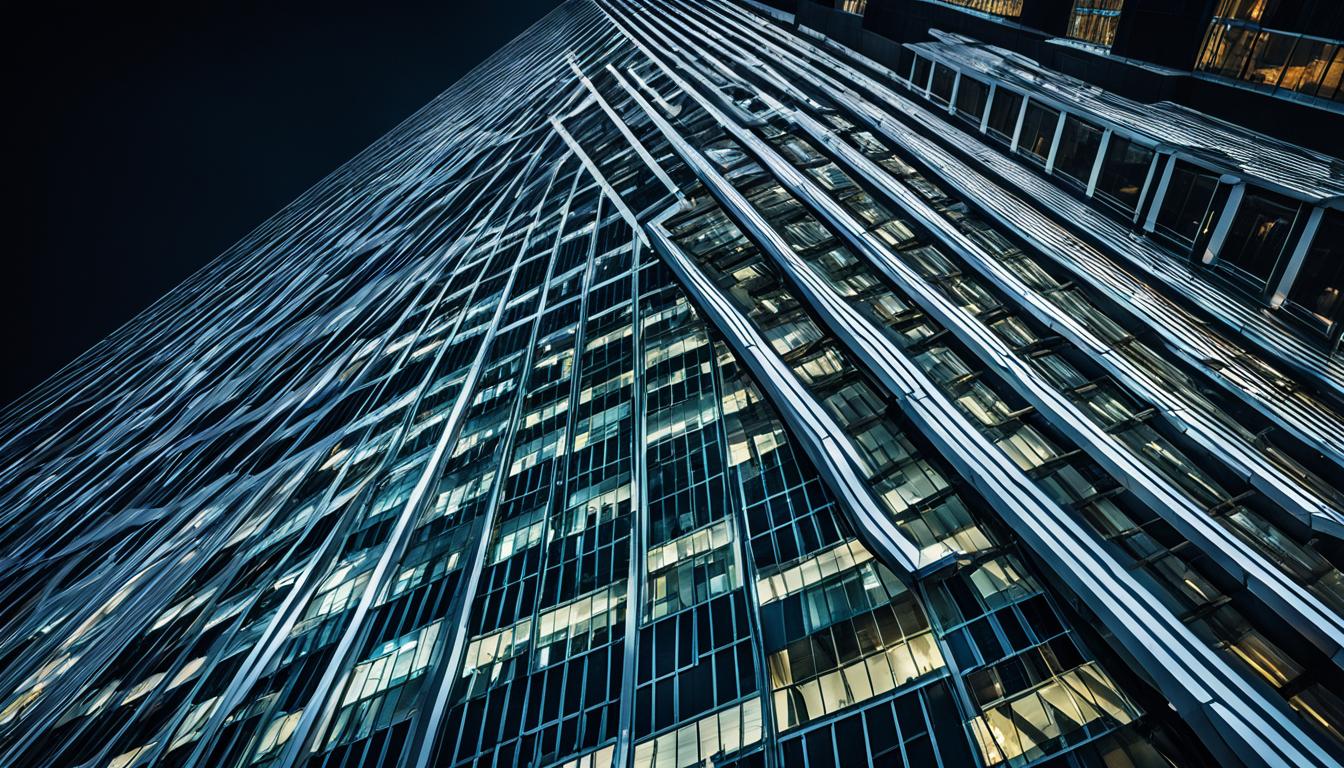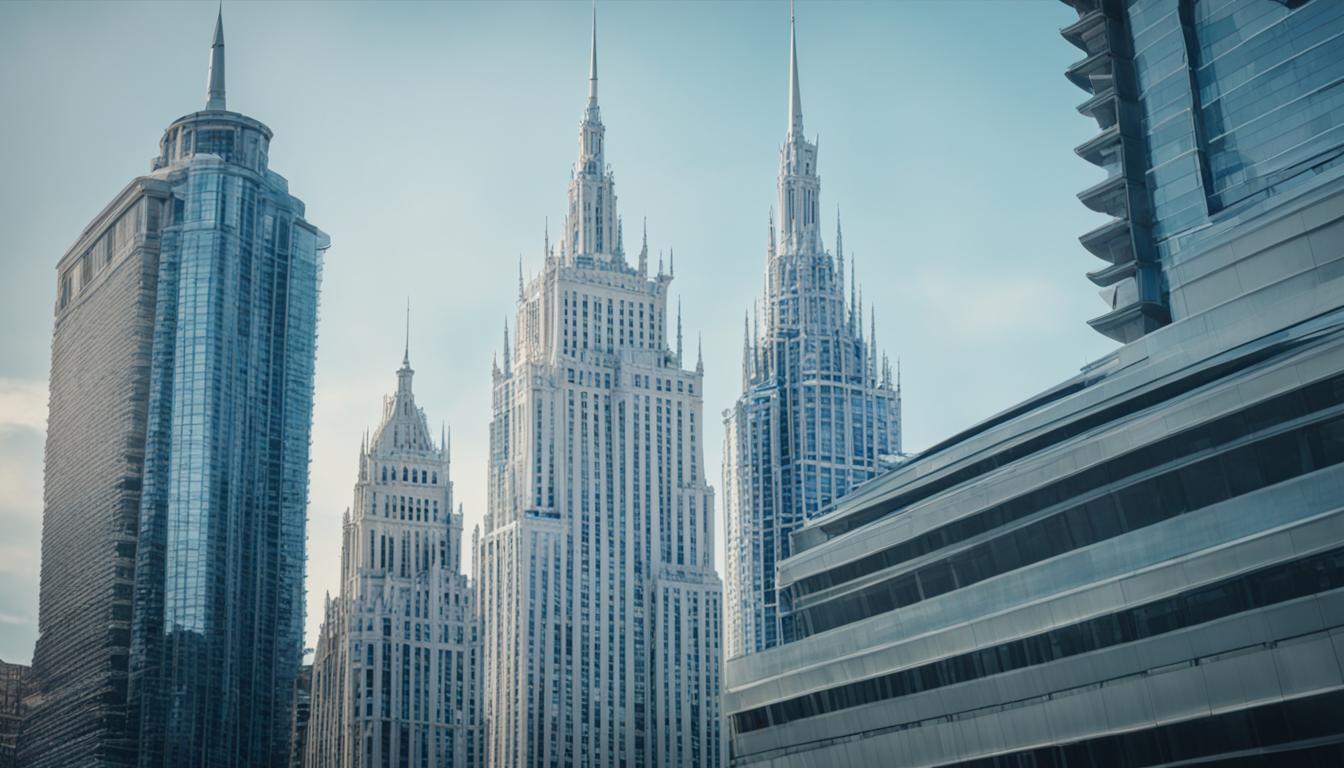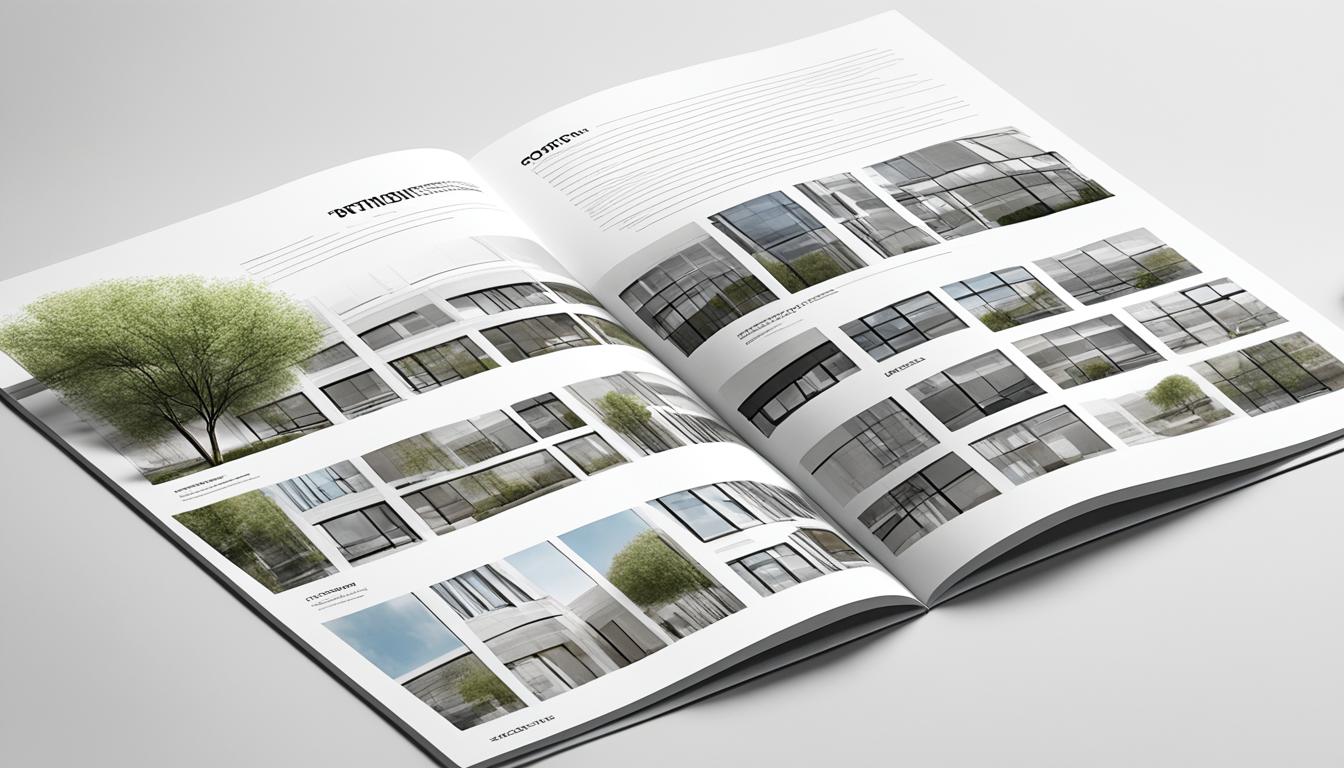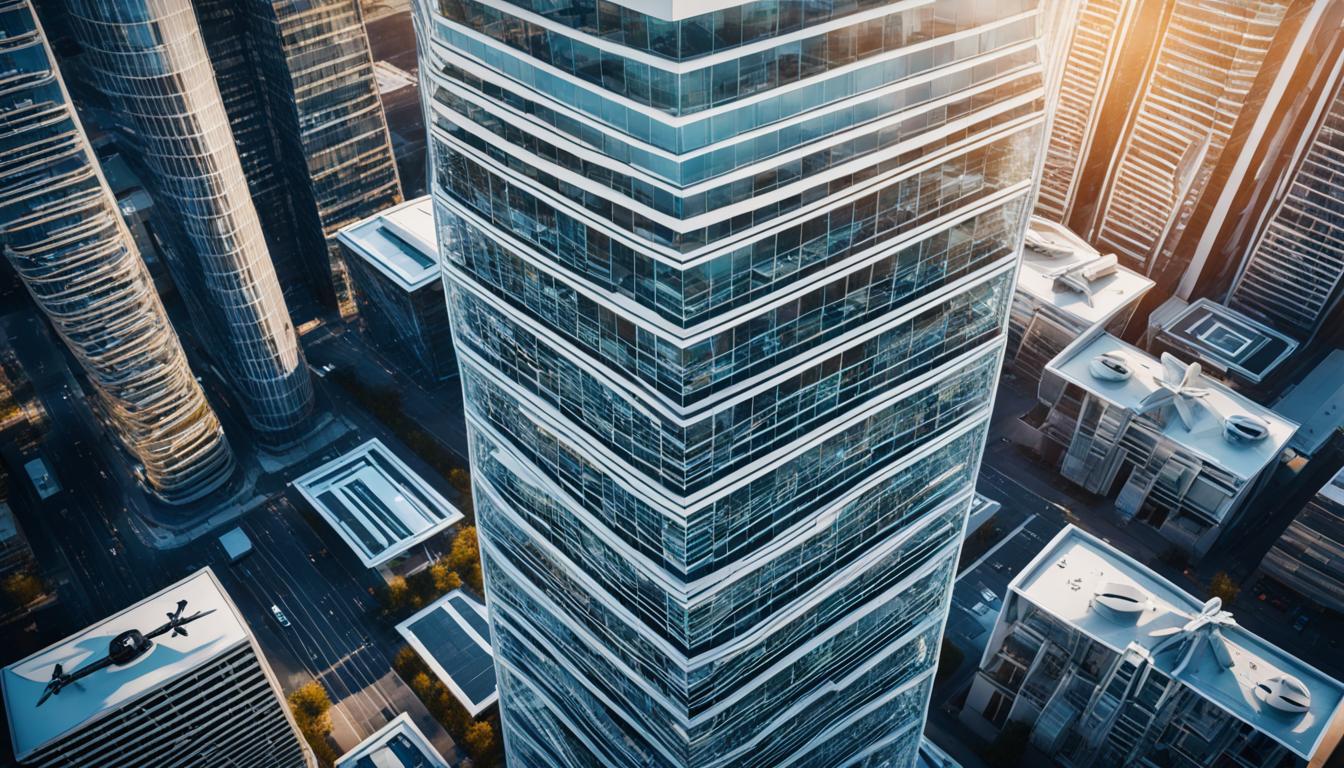Welcome to our guide on night photography in architecture! Capturing stunning images of architectural marvels after dark can be both challenging and rewarding. In this article, we will share valuable tips and insights to help you master the art of night photography and create mesmerizing compositions of urban landscapes.
Architecture photography is a fascinating genre that allows us to appreciate the beauty, lines, and textures of buildings. When it comes to photographing buildings at night, there are a few key considerations to keep in mind. By being mindful of these aspects and using the right techniques, you can bring out the unique character and ambiance of architectural structures under the night sky.
Key Takeaways:
- Pay attention to the direction of light and use exposure compensation to handle contrast.
- Consider using a fish eye or wide-angle lens to capture the entire building in its environment.
- Experiment with panoramic format for wider scenes.
- Ensure correct white balance and use long-exposure techniques or supplementary lighting for interior shots.
- Explore different lighting conditions, like shooting at night or during the golden hour, to add depth to your photographs.
The Importance of Lighting in Architecture Photography
When it comes to capturing breathtaking images of architecture, one aspect that cannot be overlooked is lighting. The right lighting can transform an ordinary building into a mesmerizing piece of art. By understanding and utilizing different lighting techniques, photographers can enhance the beauty and uniqueness of architectural structures.
Architectural lighting techniques involve being aware of the direction of light and using it to enhance contrast, shadows, textures, and reflections in photographs. By strategically capturing the play of light and shadow, photographers can create images that highlight the architectural details and bring out the character of the buildings.
Cityscape photography and urban photography provide excellent opportunities to experiment with various lighting conditions. Shooting at night or during the golden hour, the period shortly after sunrise or before sunset, can add depth and dimension to architectural photographs. The warm, soft light during the golden hour can cast a magical glow on the buildings, creating a captivating atmosphere.
“Lighting is an essential tool in architecture photography. It allows us to shape the scene, emphasize the architectural features, and create a mood that tells a story.” – John Smith, professional architectural photographer
Experimenting with different lighting conditions and techniques is key to truly mastering architecture photography. Understanding how light interacts with various materials and surfaces can help photographers make informed decisions about composition and exposure settings.
Creating Dramatic Shadows and Silhouettes
One effective technique is to capture dramatic shadows and silhouettes. By positioning the camera so that the light source is behind the building, the photographer can create a striking image with dark shadows and a strong sense of depth. This technique can add a touch of mystery and drama to architectural photographs, highlighting the unique form and shape of the building.
Utilizing Artificial Lighting
In addition to natural light, photographers can also experiment with artificial lighting to showcase architectural details. Architectural lighting fixtures, such as spotlights or specialized LED lights, can be used to highlight specific areas of the building. This technique can draw attention to intricate designs, textures, or interesting architectural elements.
When using artificial lighting, it’s essential to strike a balance and avoid overpowering the natural beauty of the building. The goal is to enhance the architectural features while maintaining a realistic representation.
Long Exposure Photography for Nighttime Scenes
For capturing cityscapes at night, long exposure photography is a powerful technique. By using a tripod and a longer shutter speed, photographers can capture the movement of lights, creating beautiful light trails and adding a sense of dynamism to the image. This technique works particularly well in urban environments, where the vibrant city lights provide a captivating backdrop.
The Magic of Reflections
Reflections can add an extra layer of interest and complexity to architecture photography. By strategically positioning the camera to capture reflections on glass facades or bodies of water, photographers can create visually striking images. The reflections can reveal another dimension of the building, adding depth and intrigue to the photograph.
Composition and Lighting
Composition plays a vital role in architecture photography, and lighting is a crucial element in creating a well-composed image. By combining an understanding of light with compositional techniques, such as the rule of thirds or leading lines, photographers can guide the viewer’s eye and create a harmonious balance within the frame.
Ultimately, mastering architectural photography requires a keen eye for lighting and how it interacts with the built environment. The careful consideration of lighting techniques can help photographers capture the true essence and beauty of architectural structures.
Composition and Perspective in Architectural Photography
Composition and perspective play vital roles in creating captivating architectural photographs. When capturing images of buildings, it’s important for us to pay attention to the lines, shapes, and symmetry present to ensure visually pleasing results.
One technique that can greatly enhance the composition is the use of leading lines. These lines guide the viewer’s eye through the image and create a sense of depth and movement. By identifying and incorporating prominent lines within the architecture, we can create dynamic and engaging compositions.
Another principle to consider is the rule of thirds. By mentally dividing the frame into thirds both horizontally and vertically, we can position the main elements of the building along these intersecting lines. This helps bring balance and visual interest to the composition.
Experimenting with different angles and perspectives is also crucial in showcasing the unique qualities of each building. Sometimes capturing a building head-on produces the most impactful image, while other times photographing it from a low or high angle can emphasize specific architectural details or create a dramatic effect.
Furthermore, symmetry can create a visually pleasing composition. Buildings with symmetrical designs can be highlighted by positioning them centrally in the frame, while asymmetrical structures may benefit from being placed off-center to create a harmonious balance.
To give you a better idea, let’s take a look at an example below:
“One of my favorite compositions showcasing the art of symmetry and leading lines is the breathtaking Taj Mahal in India. In this photograph, I positioned the Taj Mahal centrally in the frame, highlighting its symmetrical design. The long reflecting pool acts as a leading line, drawing the viewer’s eye toward the iconic structure. The clear blue sky and the surrounding gardens provide a beautiful backdrop that complements the white marble of the monument. This composition creates a sense of grandeur and serenity perfectly capturing the essence of the Taj Mahal.”
“The composition of a photograph is as important as the building itself. By carefully considering the lines, shapes, symmetry, and perspective, we can create visually striking images that capture the true essence of architecture. Experimenting with different techniques and angles will help us push the boundaries of our creativity and showcase the unique qualities of each architectural masterpiece.”
| Composition Techniques | Description |
|---|---|
| Leading Lines | Utilize prominent lines within the architecture to guide the viewer’s eye and create depth. |
| Rule of Thirds | Position the main elements of the building along the intersection points of an imaginary grid divided into thirds to create balance and visual interest. |
| Angles and Perspectives | Experiment with different angles and perspectives to emphasize architectural details and create a unique visual impact. |
| Symmetry | Highlight the symmetrical design of buildings by centralizing them in the frame or use off-center positioning for asymmetrical structures. |

By incorporating these composition techniques and exploring different perspectives, we can elevate our architectural photography, capturing the true beauty and essence of buildings.
Tips for Capturing Historic Buildings and Interiors
When photographing historic buildings and interiors, we need to approach the subject with respect and a deep understanding of their history. This is crucial to capturing their essence and telling a more comprehensive story through our photographs.
To start, conducting thorough research on the building beforehand can provide valuable insights and add depth to our images. Understanding the historical and architectural significance allows us to capture the unique character of these historic spaces.
One important aspect to pay attention to is the details. Historic buildings often boast intricate textures, materials, and architectural features that can add authenticity to our images. By zooming in on these elements, we can showcase the craftsmanship and artistry of the building.
Applying appropriate lighting techniques is also crucial when capturing historic interiors. Natural light can enhance the ambiance and highlight specific details, but in low-light conditions, supplementary lighting may be necessary. By skillfully using light, we can bring out the beauty and atmosphere of the space.
The composition is another vital element in capturing the essence of a historic building or interior. By experimenting with different angles and perspectives, we can emphasize the unique qualities of each space. The use of leading lines and the rule of thirds can help guide the viewer’s eye and create a balanced composition.
“Detail is the key to capturing the soul of a historic building. Each architectural feature tells a story and adds to the grand narrative of our collective history.”
By combining our knowledge of the building’s history, attention to details, appropriate lighting techniques, and thoughtful composition, we can create compelling images that preserve and celebrate the rich heritage of these historic spaces.
Let’s take a moment to appreciate the beauty and authenticity of a historic building captured through photography:
Tips for Capturing Historic Buildings and Interiors
| Tip | Description |
|---|---|
| Research the history | Gain insights and understand the significance of the building. |
| Focus on details | Capture the intricate textures, materials, and architectural features. |
| Use appropriate lighting | Optimize natural light and use supplementary lighting when necessary. |
| Experiment with composition | Utilize different angles and perspectives to showcase the unique qualities of the space. |
Mastering Nighttime Photo Editing for Architecture Photography
Nighttime photo editing is an essential skill for architecture photographers. While capturing stunning shots is already a great achievement, enhancing them through post-processing can take your work to the next level. By employing various editing techniques, you can bring out the details and mood of your nighttime shots, creating images that truly captivate viewers.
One of the first steps in nighttime photo editing is adjusting the exposure. This allows you to balance the brightness and darkness in your image, ensuring that both the highlights and shadows are well-preserved. Additionally, enhancing the colors can add depth and vibrancy to your photographs, making them visually appealing. Be careful not to overdo it, as maintaining a natural and realistic color balance is key.
Noise can be a common issue in nighttime photography, especially when shooting at higher ISOs. To reduce noise in your images and retain sharpness, consider using noise reduction tools in your preferred editing software. This will help ensure that your final photographs have a clean and smooth appearance.
Long exposure photography is often employed in architectural photography, adding a sense of motion and light trails to the composition. To achieve this effect, blending or stacking multiple exposures can help create stunning images with rich colors and sharp details. Experimenting with different editing styles and techniques can also add a unique touch to your final photographs, allowing you to develop a distinct aesthetic that sets your work apart.
Remember, nighttime photo editing is not just about enhancing the technical aspects of your images. It’s also about capturing the mood and atmosphere of the scene, allowing viewers to feel immersed in the architectural marvels you photograph. By mastering nighttime photo editing techniques, you can transform your nighttime architecture photography into breathtaking works of art.
“Nighttime photo editing is the bridge that connects the raw beauty of nighttime shots to the viewer’s emotions and appreciation.”
Let’s take a moment to appreciate the power of nighttime photo editing. Here’s an example of how editing can transform a nighttime architecture photograph:

| Before Editing | After Editing |
|---|---|
As you can see, editing can bring out the fine details, enhance the colors, and create a more visually striking image.
Key Takeaways:
- Nighttime photo editing is essential for enhancing the details and mood of nighttime architecture shots.
- Adjusting exposure, enhancing colors, and reducing noise are key post-processing techniques.
- Long exposure photography, combined with editing techniques like stacking or blending, can create stunning images.
- Experimenting with different editing styles can help you develop a unique aesthetic.
Gear Recommendations for Architectural Photography
When it comes to gear for architectural photography, having the right equipment can make a significant difference in the quality of the images. To capture the full beauty of architectural structures, it’s essential to invest in the proper photography gear. Here are some recommended tools for architectural photography:
1. Wide-angle lenses
A wide-angle lens, such as a fish-eye or wide-angle zoom lens, is highly recommended for capturing the entire building within its surroundings. These lenses allow you to capture the grandeur of the architecture and provide a sense of the building’s scale and context. Wide-angle lenses also help enhance the depth and perspective of the images, creating visually stunning compositions.
2. Tilt-shift lenses
Tilt-shift lenses are a valuable addition to an architectural photographer’s gear kit. These lenses can help correct perspective distortion and keep vertical lines straight, especially when photographing tall buildings. Tilt-shift lenses allow you to capture the architecture in its true form, eliminating the distortion that can occur with regular lenses.
3. Sturdy tripod and remote shutter release
A sturdy tripod is an essential tool for architectural photography, as it provides stability and eliminates camera shake. Using a tripod allows you to shoot at slower shutter speeds, resulting in sharper images, especially in low-light conditions. Additionally, a remote shutter release enables you to capture images without touching the camera, ensuring maximum sharpness and clarity.
4. Various filters
Filters can be used to enhance the quality of architectural images. Neutral density (ND) filters can help control exposure in bright lighting conditions, allowing you to capture long-exposure shots and create stunning effects. Graduated neutral density (GND) filters can be used to balance exposure between the sky and the foreground, resulting in well-exposed images with detail in both areas. Polarizing filters can also be beneficial for reducing glare and enhancing colors, particularly when photographing reflective surfaces.
By investing in the right gear, you can elevate your architectural photography to new heights, capturing the intricate details and grandeur of buildings with precision and creativity.
| Gear | Recommended Brands |
|---|---|
| Wide-angle lens | Nikon, Canon, Sony |
| Tilt-shift lens | Canon, Nikon, Sony |
| Sturdy tripod | Manfrotto, Gitzo, Benro |
| Remote shutter release | Canon, Nikon, Sony |
| Neutral density filter | Lee Filters, B+W, Hoya |
| Graduated neutral density filter | Lee Filters, Formatt-Hitech, Cokin |
| Polarizing filter | Hoya, B+W, Tiffen |
Conclusion
Night photography in architecture offers us a unique opportunity to capture the beauty and essence of buildings after dark. With careful consideration of lighting, utilization of different techniques, and the right gear, we can create stunning images that showcase the architectural marvels of cities.
Whether we’re aiming to capture the intricate details of historic buildings or the modern lines of contemporary architecture, night photography allows us to explore the nighttime urban canvas in a creative and captivating way. By being sensitive to the direction of light, adjusting exposure, and using supplementary lighting techniques, we can handle the high levels of contrast and capture the true essence of these architectural wonders.
Moreover, the right gear plays a crucial role in achieving the best results. Wide-angle lenses, such as fish eye or wide-angle zoom lenses, enable us to frame the entire building within its environment, while tilt-shift lenses help correct perspective distortion and keep vertical lines straight. Coupled with a sturdy tripod, remote shutter release, and various filters, we can capture sharp and well-exposed images.
In conclusion, night photography in architecture requires a thoughtful approach and attention to detail. By utilizing architecture photography tips and night photography techniques, we can create extraordinary images that tell captivating stories of our cities’ architectural heritage. So grab your camera, head out into the night, and let your creativity shine!
FAQ
What are some tips for night photography in architecture?
To capture stunning images at night, be sensitive to the direction of light and use exposure compensation to handle high contrast. Consider using a fish eye or wide-angle lens for framing the entire building, and experiment with long-exposure techniques or supplementary lighting for interior shots.
How does lighting play a crucial role in architecture photography?
By being aware of the direction of light, photographers can enhance contrast, shadows, textures, and reflections in their images. Understanding proper lighting techniques can bring out the unique features of a building and create captivating compositions.
What elements contribute to compelling architectural photographs?
Composition and perspective are key elements in capturing compelling architectural photographs. Pay attention to the lines, shapes, and symmetry of the buildings to create visually pleasing images. Techniques like leading lines and the rule of thirds can guide the viewer’s eye and create a sense of balance.
How should photographers approach photographing historic buildings and interiors?
When photographing historic buildings and interiors, it’s important to approach the subject with respect and knowledge of its history. Researching the building beforehand can provide valuable insights and help tell a comprehensive story through the photographs. Pay attention to details, such as textures, materials, and architectural features, to add depth and authenticity to the images.
What are some nighttime photo editing techniques for architecture photography?
Nighttime photo editing is essential for architecture photographers. Techniques such as adjusting exposure, enhancing colors, and reducing noise can bring out the details and mood of nighttime shots. Experimenting with long exposure photography and editing techniques like stacking or blending multiple exposures can create stunning images with rich colors and sharp details.
What gear is recommended for architectural photography?
Having the right equipment can make a significant difference in the quality of architectural images. Wide-angle lenses, tilt-shift lenses, sturdy tripods, remote shutter releases, and various filters are recommended for capturing well-exposed and sharp images.
How does night photography in architecture allow photographers to showcase urban landscapes creatively?
Night photography in architecture offers photographers a unique opportunity to capture the beauty and essence of buildings after dark. By being sensitive to lighting, utilizing different techniques, and using the right gear, photographers can create stunning images that showcase the architectural marvels of cities and explore the nighttime urban canvas in a captivating way.
How Can Night Photography Techniques be Adapted for Eco-Friendly Architectural Photography?
When practicing ecofriendly architectural photography tips for night photography, it’s important to utilize natural or existing lighting to minimize energy consumption. Long exposure techniques can capture the beauty of the architecture while reducing the need for artificial light. Additionally, post-processing software can enhance the images without the need for excessive lighting.




